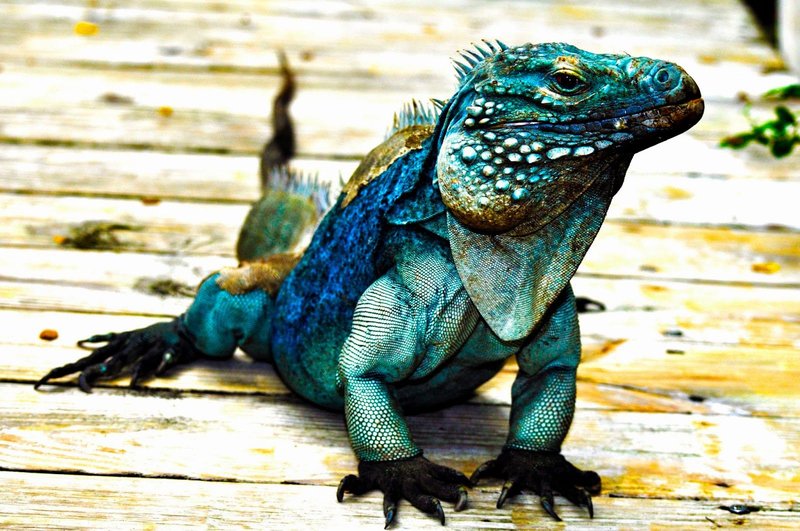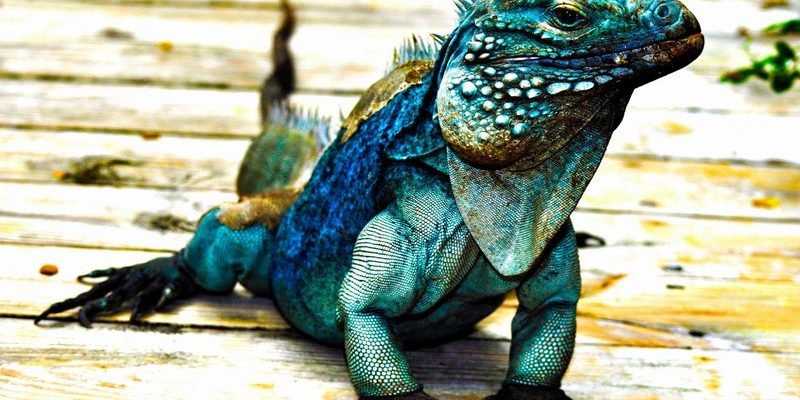
Before we get too far, it’s important to note that blue iguanas are not your average pet; they require specific conditions and care. If you’re considering one, it’s like signing up for a new hobby that requires some study, just like learning to play an instrument. You wouldn’t jump in without knowing how to hold the guitar, right? Let’s explore all the ins and outs of owning a blue iguana to help you decide if this exotic pet is the right choice for you.
What Makes Blue Iguanas Unique?
Blue iguanas, scientifically known as *Cyclura lewisi*, are native to the Grand Cayman Islands. Their vibrant blue skin, which can range from sky blue to deep turquoise, sets them apart from other iguana species. But more than their looks, these reptiles have a fascinating story. They are considered endangered, with conservation efforts underway to protect their populations. So, owning one not only gives you a cool pet but also connects you to a larger mission of conservation.
Blue iguanas show a mix of personality traits. They can be curious and (believe it or not) somewhat affectionate toward their owners. Unlike some reptiles that prefer solitude, blue iguanas can enjoy gentle interactions, which is part of what makes them appealing as pets. However, they can also be quite shy, requiring time to adapt to their new environment and the presence of humans.
Are Blue Iguanas Suitable for Beginners?
If you’re new to reptile care, you might be wondering if a blue iguana is the right choice for you. Honestly, it depends on your commitment and willingness to learn. While they’re not the easiest reptiles to care for, they can be rewarding pets for dedicated beginners. However, it’s essential to understand that they need specialized care.
You might think of them as a long-term commitment—as long as 20 years! Blue iguanas require specific environmental conditions, a balanced diet, and regular monitoring of their health. If you have the passion to learn and provide what they need, you can absolutely have a successful relationship with a blue iguana.
Essential Care Requirements
Caring for a blue iguana isn’t just about feeding and cleaning. Here are some essential care requirements to keep in mind:
- Habitat: A spacious enclosure is crucial. Blue iguanas need room to roam and climb, ideally a setup of at least 6 feet long, with vertical height for climbing.
- Temperature: They need a basking spot of around 95°F (35°C) with cooler areas to retreat to, ensuring they can regulate their body temperature.
- Humidity: Keeping humidity levels between 60-80% is vital. Regular misting and a suitable water source help keep their skin healthy.
- Diet: A varied diet is important—think leafy greens, vegetables, and occasional fruits. Avoid high-fat or high-protein foods.
Setting up an appropriate habitat can feel a bit overwhelming, but once you’ve got it down, it’s like having a mini rainforest in your living room!
Handling and Socialization
You might be curious about how to handle your new blue iguana. Socialization is key. These guys can be skittish, especially when you first bring them home. It’s essential to take your time. Start by simply sitting near their enclosure to help them get used to your presence.
When you do begin handling them, support their body fully to make them feel secure. Avoid sudden movements, which can startle them. Think of it this way—if you were a shy kid at a party, you wouldn’t want someone to rush over and grab your hand! Some patience goes a long way in building trust.
Potential Challenges
While the prospect of owning a blue iguana can be exciting, it’s also important to recognize potential challenges. For one, they can be** sensitive** to stress. Changes in their environment can cause them to become anxious, which could lead to health issues. Consistency in their daily routine is vital.
Additionally, blue iguanas can develop dietary deficiencies if not fed a balanced diet. It’s like trying to fuel a car with the wrong type of gas; without the right nutrition, they won’t thrive. Regular vet check-ups are important to catch any health problems early and to ensure they’re growing as they should.
You might also encounter shedding periods, where they’ll require additional humidity and care. But don’t worry—this is completely normal for reptiles.
Finding the Right Blue Iguana
If you’re sold on getting a blue iguana, where do you find one? Look for reputable breeders or rescue organizations that specialize in reptiles. It’s crucial to avoid pet stores that may not have the best care practices. A responsible breeder will provide you with a healthy iguana and the necessary documentation.
Before bringing your new companion home, it’s a good idea to ask about the iguana’s background, including its diet and health status. This information can help you transition them smoothly. You want to ensure you’re getting a pet that has been raised with care, so you can start this exciting journey on the right foot.
Final Thoughts
So, is a blue iguana a good pet for beginners? If you’re ready to invest time and effort, the answer is a resounding yes. These unique reptiles can bring a splash of color and a lot of joy into your life, not to mention the satisfaction of caring for a creature with such a rich history. Just remember, they need the right environment, diet, and attention to truly thrive.
Ultimately, much like any pet, the bond you build with a blue iguana can be incredibly rewarding. With proper care and a little patience, you’ll have a remarkable companion. So, if you’re up for the challenge, let the adventure begin!

